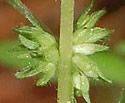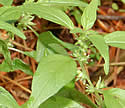Parietaria pensylvanica (Pennsylvania Pellitory)
| Also known as: | |
|---|---|
| Genus: | Parietaria |
| Family: | Urticaceae (Nettle) |
| Life cycle: | annual |
| Origin: | native |
| Habitat: | part shade, shade; disturbed soil; woods, thickets, waste areas |
| Bloom season: | May - September |
| Plant height: | 6 to 18 inches |
| Wetland Indicator Status: | GP: FAC MW: FACU NCNE: FACU |
| MN county distribution (click map to enlarge): |  |
| National distribution (click map to enlarge): |  |
Pick an image for a larger view. See the glossary for icon descriptions.
Detailed Information
Flower: 

![[photo of flowers]](/udata/r9ndp23q/green/pennsylvania-pellitory_0720_100216-t.jpg) Tiny indistinct flowers compactly clustered in the mid and upper leaf axils, the cluster surrounded by a leafy bract. Separate male and female flowers may be present as well as flowers with both male and female parts (perfect). The bract lobes are narrow with pointed tips and slightly hairy.
Tiny indistinct flowers compactly clustered in the mid and upper leaf axils, the cluster surrounded by a leafy bract. Separate male and female flowers may be present as well as flowers with both male and female parts (perfect). The bract lobes are narrow with pointed tips and slightly hairy.
Leaves and stems: 

![[photo of leaves]](/udata/r9ndp23q/green/pennsylvania-pellitory_0720_100256-t.jpg) Leaves are thin, 1 to 3 inches long, up to ½ inch wide, mostly lance-shaped with a blunt or pointed tip, toothless, sparsely hairy, on a stalk up to 1 inch long, alternately attached, with 3 distinct veins coming from the base. Stems are weak and erect to reclining, sparsely hairy, sometimes branched but typically not.
Leaves are thin, 1 to 3 inches long, up to ½ inch wide, mostly lance-shaped with a blunt or pointed tip, toothless, sparsely hairy, on a stalk up to 1 inch long, alternately attached, with 3 distinct veins coming from the base. Stems are weak and erect to reclining, sparsely hairy, sometimes branched but typically not.
Notes:
Pennsylvania Pellitory is generally considered a (native) urban weed, popping up in disturbed soil along the sides of buildings, woods and thickets, and gardens. It has a preference for light shade and can form colonies where there is little competition. I first noticed it in my own suburban back yard after clearing out an area to plant new shrubs. It is a persistent annual but not very aggressive like invasive species are. It is similar in structure to Three-seeded Mercury (Acalypha rhomboidea) which is a larger plant with toothed leaves. It is also in the same family as Stinging Nettle, but does not have stinging hairs.
Native Plant Nurseries, Restoration and Landscaping Services ↓
More photos
Photos by K. Chayka taken at Vadnais/Snail Lake Regional Park, Ramsey County.
Comments
Have you seen this plant in Minnesota, or have any other comments about it?
on: 2014-06-29 20:04:07
This plant grows in many areas of our yard, and forms large colonies in shady areas under trees and raspberry canes. I considered it a somewhat annoying weed until I found out that it, like other nettle family plants, is a host for the caterpillars of the red admiral butterfly. I saw a red admiral laying its eggs on them, and I noticed a tiny caterpillar on one that I pulled up. Now I've decided to let the large colonies live, because I'd like to help the butterflies along, except when they're growing over other more desirable plants. They're very easy to pull up, because they seem to have shallow roots (even in very dry soil; maybe the roots are deeper, but just very thin and brittle). The bracts around the flowers are clingy and stick weakly to my hands when I touch them. I haven't investigated if this is the effect of tiny hairs or what. They don't have any stinging hairs; perhaps the clinginess is due to the same sort of structure that would be a stinging hair in another nettle species.
on: 2015-11-18 22:38:30
My dog seeks this plant out and eats it like candy. It seems to make her violently sick to her stomach. No one seems to be able to tell me if this plant is lethally poisonous (Long term) or just a big stomach irritant. Trying here to see if you all can help me. Thanks.
on: 2015-11-19 06:19:35
We don't know if Parietaria pensylvanica is toxic or not. Nothing jumped out about this in a quick web search. Maybe ask your vet about it.
on: 2018-09-25 20:19:15
mostly in the shade between fence and cultivated plants. Removed them while weeding the bed for folks I was visiting. Pressed the specimens- probably will end up at EKY.
on: 2019-07-13 07:11:45
Pennsylvania pellitory is edible and should not be problem for dogs.
on: 2020-07-10 17:07:12
I was investigating this weed as I have a lot of it in my flower beds. I suspected it also to be a cause of a rash when I pick it but I don't know that for certain. Any thoughts on this? I thought it might be when I saw it is in the Nettle family
on: 2022-06-11 15:36:30
Native or not, I loathe this plant. I cannot get rid of it and am allergic to it.
on: 2022-06-12 11:53:10
Erika, just because it's native doesn't mean it's desirable!
on: 2022-06-22 11:10:36
Oh, didn't know it was native. I wonder what the genus name refers to? Thanks for your work!
on: 2022-06-23 16:15:41
Molly, per the Wisconsin Flora website: Etymology: Parietaria: derives from Latin parietarius, "of walls," which descends from Greek paries, "a wall," where the plant likes to grow, as Pliny [the Elder] knew when he described it.
on: 2023-03-02 07:34:06
Some individuals may suffer a mild allergic reaction as a result of eating pennsylvania pellitory's leaves or stem. This can lead to symptoms such as itchiness all over the skin or hives. Pollen is a severe allergen.
on: 2023-10-05 15:07:56
I have pulled this out by hand before learning it was native, and didn't suffer any hives. Does that mean I can eat it without an allergic reaction?
on: 2023-10-05 17:43:39
Ellen, Minnesota Wildflowers cannot provide medical advice.







 Pennsylvania Pellitory plant
Pennsylvania Pellitory plant a colony of Pennsylvania Pellitory
a colony of Pennsylvania Pellitory